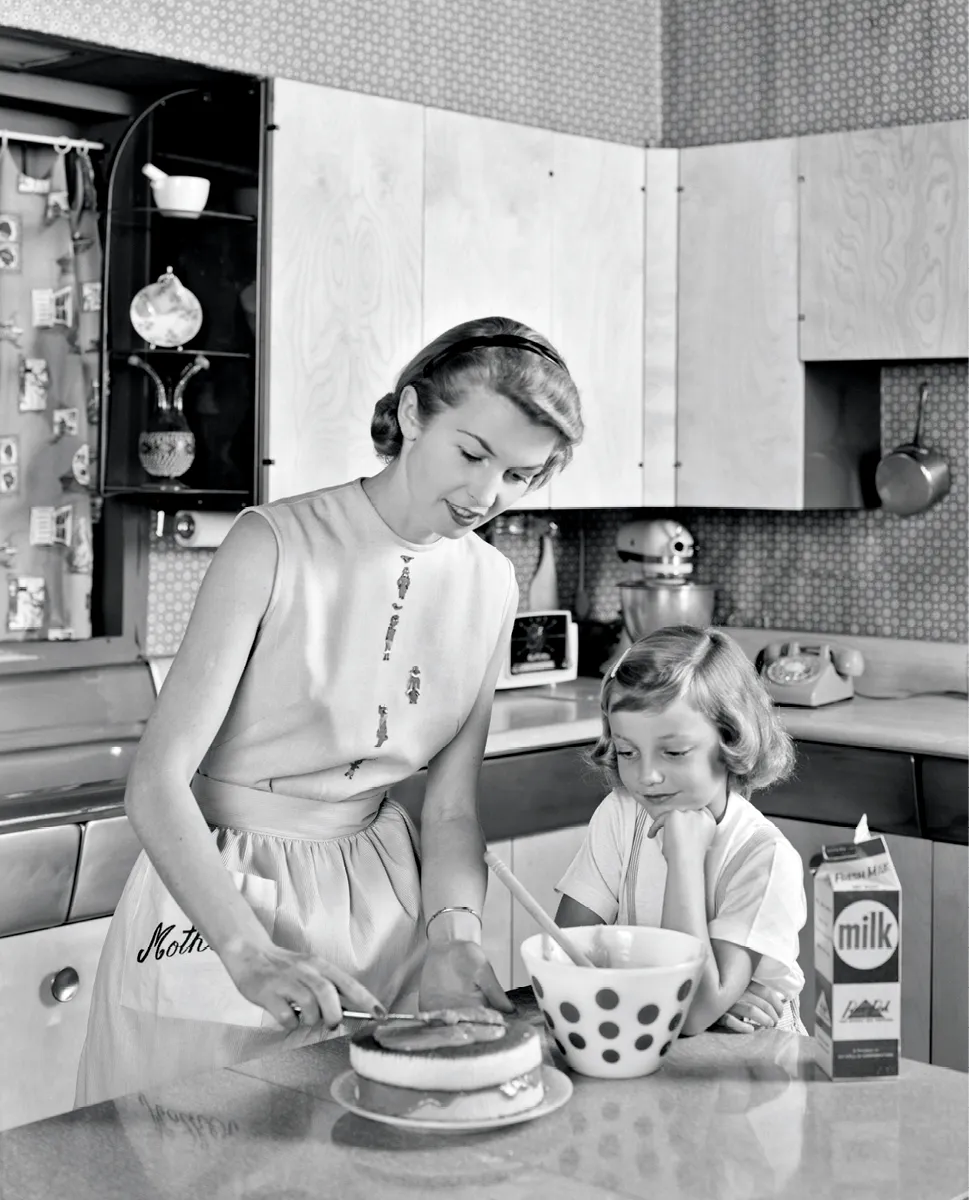Ressource affichée de l'autre côté.
Faites défiler pour voir la suite.
Faites défiler pour voir la suite.
Group 1
Each group is in charge of one document. Study it and
Ressource affichée de l'autre côté.
Faites défiler pour voir la suite.
Faites défiler pour voir la suite.
Picture


Ressource affichée de l'autre côté.
Faites défiler pour voir la suite.
Faites défiler pour voir la suite.
How They Raised Girls To Be Women In The 1950s.
Ressource affichée de l'autre côté.
Faites défiler pour voir la suite.
Faites défiler pour voir la suite.
Group 2
Each group is in charge of one document. Study it and
Ressource affichée de l'autre côté.
Faites défiler pour voir la suite.
Faites défiler pour voir la suite.
Text document
As men age, they continue to follow dominant ideas of masculinity learned as youth, leaving them unequipped for the assaults of age [...]. Men who embodied the prevailing1 culture and societal hallmarks of manliness as younger men‒projecting an aura of toughness and independence, avoiding crying and vulnerability, while courageously taking risks- are confronted by the development of health problems, loss of spouses and loved ones, retirement and needing to be a caregiver for ailing2 family members in later life. [...]
This masculinity “script” still embraced by older men was outlined as the four-part Blueprint of Manhood, first published by sociologist Robert Brannon when the men in the studies were entering adulthood in the 1970s. The blueprint3 included:
No Sissy Stuff - men are to avoid being feminine, show no weakness and hide intimate aspects of their lives.
The Big Wheel - men must gain and retain respect and power and are expected to seek success in all they do.
The Sturdy Oak - men are to be “the strong, silent type” by projecting an air of confidence and remaining calm no matter what.
Give ‘em Hell - men are to be tough, adventurous, never give up and live life on the edge.
This masculinity “script” still embraced by older men was outlined as the four-part Blueprint of Manhood, first published by sociologist Robert Brannon when the men in the studies were entering adulthood in the 1970s. The blueprint3 included:
No Sissy Stuff - men are to avoid being feminine, show no weakness and hide intimate aspects of their lives.
The Big Wheel - men must gain and retain respect and power and are expected to seek success in all they do.
The Sturdy Oak - men are to be “the strong, silent type” by projecting an air of confidence and remaining calm no matter what.
Give ‘em Hell - men are to be tough, adventurous, never give up and live life on the edge.
1. predominant
2. with poor health
3. scheme
“Older Men Cling to 1950s, ‘60s Blueprint of Masculinity”
Ressource affichée de l'autre côté.
Faites défiler pour voir la suite.
Faites défiler pour voir la suite.
Group 3
Each group is in charge of one document. Study it and
Ressource affichée de l'autre côté.
Faites défiler pour voir la suite.
Faites défiler pour voir la suite.
Text document
A lot has changed since the 1950s. [...]
Not so long ago a man would have no option but to spend most of his time working because it was common knowledge that men were not emotionally competent enough to raise their babies and children. It was better for a man to come in with an iron fist1 at the end of the day, so that the children would be scared of him and toe the line. Wait till your father gets home!
This was the way it was meant to be because men were more competitive and adventurous. A man wasn't a natural carer and wasn't outwardly2 affectionate. [...]
If he was exposed to the genuine3 emotions of others, or became more directly responsible for the emotional development of his children, he might realise his own emotional depth; he might lose the ability to push his emotion aside or hide it away. If that happened to a man, it would make it impossible for him to be the singularly focused, iron fist, the world, the workplace, and the family required him to be. Pride, aggression and anger and any form of expression that provided him with control were allowed but if he expressed any other emotion, well, he simply wasn't a man, and not being a man in a patriarchal world – we all know – is a pretty damning thing.
Not so long ago a man would have no option but to spend most of his time working because it was common knowledge that men were not emotionally competent enough to raise their babies and children. It was better for a man to come in with an iron fist1 at the end of the day, so that the children would be scared of him and toe the line. Wait till your father gets home!
This was the way it was meant to be because men were more competitive and adventurous. A man wasn't a natural carer and wasn't outwardly2 affectionate. [...]
If he was exposed to the genuine3 emotions of others, or became more directly responsible for the emotional development of his children, he might realise his own emotional depth; he might lose the ability to push his emotion aside or hide it away. If that happened to a man, it would make it impossible for him to be the singularly focused, iron fist, the world, the workplace, and the family required him to be. Pride, aggression and anger and any form of expression that provided him with control were allowed but if he expressed any other emotion, well, he simply wasn't a man, and not being a man in a patriarchal world – we all know – is a pretty damning thing.
1. with a firm, strong hand
2. superficially
3. authentic, real
“The 1950s Man in Me”
Ressource affichée de l'autre côté.
Faites défiler pour voir la suite.
Faites défiler pour voir la suite.
Questions
You are in charge of one document.
Share your findings classmates and learn about the other documents.
b. Explain what a traditional family would have looked like back then. To what extent were people free to lead their lives as they wished?
1
How are traditional gender roles portrayed in your document? Do you agree with it?2
How were children raised in the 1950s? What were the consequences of this education?
Useful vocabulary
Girls / Boys were expected to behave...
The rules dictated that... ...was considered unnatural
The rules dictated that... ...was considered unnatural
Let's talk this out!
Mediation
Share your findings classmates and learn about the other documents.
3
a. Compare and contrast the roles of men and women in the 1950s.
b. Explain what a traditional family would have looked like back then. To what extent were people free to lead their lives as they wished?
4
How different were education and life in the 1950s compared to today?Useful vocabulary
The main difference is that...
In the 1950s, education was... whereas today it is...
I think / don't think it is dramatically different since / because / as...
In the 1950s, education was... whereas today it is...
I think / don't think it is dramatically different since / because / as...
Ressource affichée de l'autre côté.
Faites défiler pour voir la suite.
Faites défiler pour voir la suite.
- dreadful / outrageous (adj.)
- hit a nerve (exp.)
- conformity (n.)
- fulfillment (n.)
- model (n.)
- mold (n.)
- indoctrinate (v.)
Toolbox
Ressource affichée de l'autre côté.
Faites défiler pour voir la suite.
Faites défiler pour voir la suite.
for / since / ago
1) A lot has changed since the 1950s.2) Men have followed the masculine blueprint for decades.
3) Not so long ago, men spent their days at work.
a. Quel temps verbal est utilisé dans les phrases ci-dessus ?
b. Quel type d'informations retrouvez-vous après since et for ?
une date précise
une durée
un point de départ temporel
•
Ressource affichée de l'autre côté.
Faites défiler pour voir la suite.
Faites défiler pour voir la suite.
Over to you!
Ressource affichée de l'autre côté.
Faites défiler pour voir la suite.
Faites défiler pour voir la suite.
Une erreur sur la page ? Une idée à proposer ?
Nos manuels sont collaboratifs, n'hésitez pas à nous en faire part.
j'ai une idée !
Oups, une coquille

